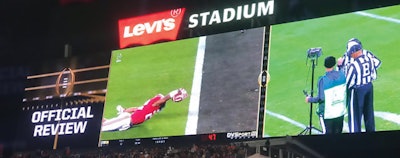
It used to be that when football coaches wanted to see how a play broke down, they'd look at still images: pre-snap, during the snap, post-snap. Some old-school coaches still prefer it this way, according to Justin Rudd, executive vice president for sales and marketing at DV Sport, but new applications for video technology have made such tactics seem antiquated.
Innovations, such as streaming video and mobile technology from video providers like DV Sport, Hudl and XOS Digital are changing the game both on the field and off.
Driving efficiency
One of the ways these companies are having an impact is by making practices more efficient. Gone are the days of reviewing and editing hours of footage. "Now you have video technology available during practice to review with your players in between drills," says Rudd, referring to DV Sport Rewind, a product that provides live video feeds and video playback. "It makes a big difference."
DV Sport Rewind allows coaches to review a play or a drill on the practice field with their teams mere moments after it happens. "Today at practice, they have the tablets out, and after a drill is complete, they will then come off of the field and be able to review the footage of the drill that just occurred and look at it from different angles," says Rudd.
That kind of efficiency can help maximize the effectiveness of the time players and coaches spend together, which in turn can help to create a competitive advantage, especially in situations where time spent between coaches and players is limited by rule. "[Coaches] can actually look at the video within seconds after a drill is over to watch it with the players, review it and make adjustments," Rudd says. "It really gives them the advantage and the opportunity to get much further in the process."
Depending on the application, the technology can be tailored to fit any given sport. For example, coaches can now pull and analyze a basketball player's jump shots taken from a particular area of the court, or a volleyball player's technique on particular hits.

Rules and regulations
Rules across different sports, leagues and levels sometimes dictate where and how video tech can be rolled out.
"It applies to equality," Rudd says. "What I mean by that is, what's to stop Alabama from hiring two additional analysts and having 12 cameras feeding into a system that allows their coaches sitting in a locker room to give real-time feedback to Nick Saban?" The implication being that smaller schools with smaller budgets might be prohibited from matching the resources available to larger schools.
For that reason, coaches aren't allowed to use video replay solutions like Rewind during NCAA football games. However, in NCAA lacrosse, where larger programs compete on a more even playing field with smaller ones, coaches can be seen with tablets, analyzing game film right on the sideline.
"Regardless of the sport, there's going to be the haves and the have-nots," Rudd says. "But in certain sports, you have a set number of coaches, or a smaller team, and it's a little bit more balanced from a competitive standpoint."
Generally, though, video solutions are allowed in some form or fashion. "You do whatever you want at practice and in your facility," Rudd says. "But when it comes to the game there are rules you need to abide by."
At the high school level, where sports are typically governed by state associations, things can get even more complicated. Some high schools are beginning to employ DV Sport, either for in-game replay or for coaching purposes, but rules will dictate what's allowed.
Improving player safety
Apart from its myriad uses as a competition or coaching tool, video solutions can also be employed by medical staff. Collegiate conferences across the NCAA are implementing DV Sport's Medical Replay solution, a valuable tool for athletic trainers.
Rudd says that Medical Replay is used primarily in two ways. First is a proactive approach. "A player takes a hit on the field, the athletic trainer can look at the video right after the play," says Rudd. "If they think the player should come out for a minute and go through some concussion protocol testing or something like that, they can certainly stop the game and have that player come out."
Video can provide athletic trainers with the evidence they need to prove to a player that they need to take a play or two off for evaluation, even if the player feels fine.
Video may also be helpful in analyzing exactly how a player was injured. For instance, a football player limping off the field, complaining of an ankle injury, might be unable to tell medical personnel exactly what happened.
"In the past, medical staff have had to try to figure out what's wrong with a player from just that little bit of information the player gave them," Rudd says. "But what they can do now is look at the video, and very quickly and easily see from all the different angles, exactly what happened to that player's ankle on that play."
Data and analytics are increasingly coming to the forefront in the world of athletics, and video can provide an added layer of analysis. Whether deployed to coach up a particular technique, or to pinpoint the exact cause of an injury, video has never been easier to put to use.
This article originally appeared in the April 2019 issue of Athletic Business with the title "New video applications are changing athletics." Athletic Business is a free magazine for professionals in the athletic, fitness and recreation industry. Click here to subscribe.





































